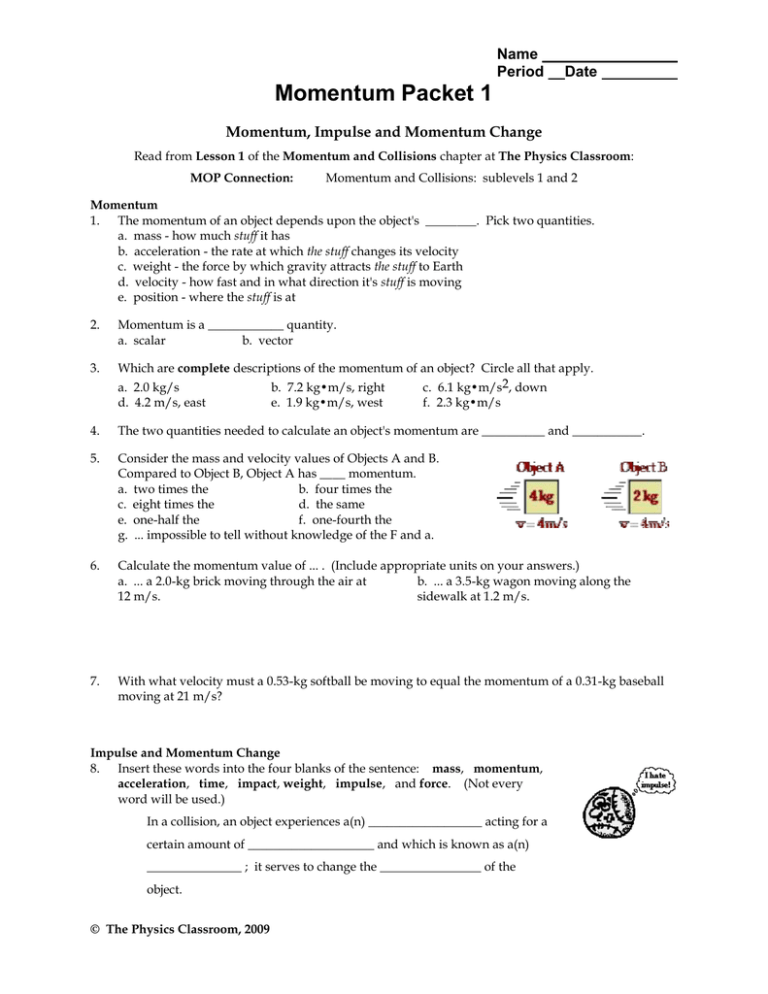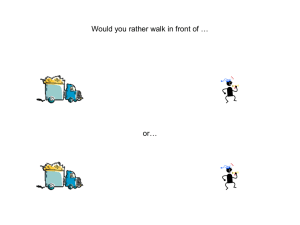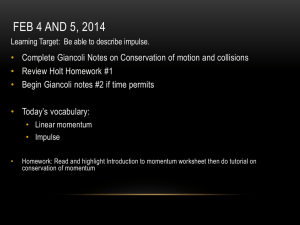Momentum Packet 1 Name Period Date
advertisement

Name Period Date Momentum Packet 1 Momentum, Impulse and Momentum Change Read from Lesson 1 of the Momentum and Collisions chapter at The Physics Classroom: MOP Connection: Momentum and Collisions: sublevels 1 and 2 Momentum 1. The momentum of an object depends upon the object's ________. Pick two quantities. a. mass - how much stuff it has b. acceleration - the rate at which the stuff changes its velocity c. weight - the force by which gravity attracts the stuff to Earth d. velocity - how fast and in what direction it's stuff is moving e. position - where the stuff is at 2. Momentum is a ____________ quantity. a. scalar b. vector 3. Which are complete descriptions of the momentum of an object? Circle all that apply. a. 2.0 kg/s b. 7.2 kg•m/s, right c. 6.1 kg•m/s2, down d. 4.2 m/s, east e. 1.9 kg•m/s, west f. 2.3 kg•m/s 4. The two quantities needed to calculate an object's momentum are __________ and ___________. 5. Consider the mass and velocity values of Objects A and B. Compared to Object B, Object A has ____ momentum. a. two times the b. four times the c. eight times the d. the same e. one-half the f. one-fourth the g. ... impossible to tell without knowledge of the F and a. 6. Calculate the momentum value of ... . (Include appropriate units on your answers.) a. ... a 2.0-kg brick moving through the air at b. ... a 3.5-kg wagon moving along the 12 m/s. sidewalk at 1.2 m/s. 7. With what velocity must a 0.53-kg softball be moving to equal the momentum of a 0.31-kg baseball moving at 21 m/s? Impulse and Momentum Change 8. Insert these words into the four blanks of the sentence: mass, momentum, acceleration, time, impact, weight, impulse, and force. (Not every word will be used.) In a collision, an object experiences a(n) __________________ acting for a certain amount of ____________________ and which is known as a(n) _______________ ; it serves to change the ________________ of the object. © The Physics Classroom, 2009 Momentum Packet 1 9. page 2 A(n) _________________ causes and is equal to a change in momentum. a. force b. impact c. impulse d. collision 10. Calculate the impulse experienced by .... . (Show appropriate units on your answer.) a. ... a 65.8-kg halfback encountering a force of 1025 N for 0.350 seconds. b. ... a 0.168-kg tennis ball encountering a force of 126 N that changes its velocity by 61.8 m/s. 11. Determine the impulse (J), momentum change (p), momentum (p) and other values. A 7-ball collides with the 8-ball. A moving medicine ball is caught by a girl on ice skates. J= J=-50 Ns A car is at rest when it experiences a forward propulsion force to set it in motion. It then experiences a second forward propulsion force to speed it up even more. Finally, it brakes to a stop. J= J= J= A tennis ball is at rest when it experiences a forward force to set it in motion. It then strikes a wall where it encounters a force that slows it down and finally turns it around and sends it backwards. J= © The Physics Classroom, 2009 J= J= Momentum Packet 1 page 3 Controlling a Collision Read from Lesson 1 of the Momentum and Collisions chapter at The Physics Classroom: MOP Connection: Momentum and Collisions: sublevel 3 Review: 1. A halfback (m = 80 kg), a tight end (m = 100 kg), and a lineman (m = 120 kg) are running down the football field. Consider their ticker tape patterns below. The lineman's velocity is 3 m/s (right). The tight end's velocity is ______ m/s and the halfback's velocity is _______ m/s. Which player has the greatest momentum and how much momentum does he have? ___________________________ Explain. 2. A football fullback is running down the field at constant speed until he encounters a defensive back. The dot diagram depicts the motion of the fullback. Indicate on the dot diagram (by means of an arrow) the approximate location at which the fullbackdefensive back collision occurs. Which direction (right or left) does the force upon the fullback act? ________ Explain how you know. What happens to the momentum of the fullback upon colliding with the defensive back? Using the F•t = m•v Equation to Analyze Impulses and Momentum Changes: 3. Two cars of equal mass are traveling down Lake Avenue with equal velocities. They both come to a stop over different lengths of time. The dot diagrams for each car are shown below. Which car (A or B) experiences the greatest acceleration? ______ Explain. Which car (A or B) experiences the greatest change in momentum? ______ Explain. Which car (A or B) experiences the greatest impulse? ______ Explain. Which car (A or B) experiences the greatest force? ______ Explain. © The Physics Classroom, 2009 Momentum Packet 1 page 4 4. When a boxer recognizes that he/she will be hit by an opposing fist, he/she rides the punch. Use physics to explain why. 5. Mountain climbers use nylon safety ropes due to their tendency to stretch considerably under stress. Use physics to explain why. Consider the diagram at the right for the next three questions. The diagram depicts Before and After velocities of an 800-kg car in two different collisions with a wall. In case A, the car rebounds upon collision. In case B, the car hits the wall, crumples up and stops. Assume that the collision time for each collision is the same. 6. In which case does the car experience the greatest momentum change? a. Case A b. Case B c. Both the same d. Insufficient information 7. In which case does the car experience the greatest impulse? a. Case A b. Case B c. Both the same d. Insufficient information 8. The impulse encountered by the 800-kg car in case A has a magnitude of ___ N•s. a. 0 b. 800 c. 3200 d. 4000 e. 7200 f. Not enough information to determine. 9. Evaluate the potential hazard to a passenger involved in a head-on collision in which the two cars stick together compared to when they rebound upon impact. Explain. 10. The diagram below depicts the changes in velocity of a ball that undergoes a collision with a wall. Indicate which case (A or B) has the greatest change in velocity, greatest acceleration, greatest momentum change, and greatest impulse. Support each answer. Greatest ∆v? _____ Explanation: Greatest a? _____ Explanation: Greatest ∆p? _____ Explanation: Greatest F∆t? _____ Explanation: © The Physics Classroom, 2009 Momentum Packet 1 page 5 Simple Computations with Impulse = Momentum Change Read from Lesson 1 of the Momentum and Collisions chapter at The Physics Classroom: A car with a mass of 1000 kg is at rest at a stoplight. When the light turns green, it is pushed by a net force of 2000 N for 10 s. 1. What is the value of the acceleration that the car experiences? 2. What is the value of the change in velocity that the car experiences? 3. What is the value of the impulse on the car? 4. What is the value of the change in momentum that the car experiences? 5. What is the final velocity of the car at the end of 10 seconds? The car continues at this speed for a while. 6. What is the value of the change in momentum the car experiences as it continues at this velocity? 7. What is the value of the impulse on the car as it continues at this velocity? The brakes are applied to the car, causing it to come to rest in 4 s. 8. What is the value of the change in momentum that the car experiences? 9. What is the value of the impulse on the car? 10. What is the value of the force (average) that causes the car to stop? 11. What is the acceleration of the car as it stops? © The Physics Classroom, 2009 Momentum Packet 1 page 6 There is a disease known as formula fixation that is common among physics students. It particularly infects those who perceive physics as an applied math course where numbers and equations are simply combined to solve algebra problems. However, this is not the true nature of physics. Physics concerns itself with ideas and concepts that provide a reasonable explanation of the physical world. When students divorce the mathematics from the ideas, formula fixation takes root and even mathematical problem solving can become difficult. Do you have formula fixation? Test your health by trying these computational problems. 12. A force of 800 N causes an 80-kg fullback to change his velocity by 10 m/s. Determine the impulse experienced by the fullback. PSYW 13. A 0.80-kg soccer ball experiences an impulse of 25 N•s. Determine the momentum change of the soccer ball. PSYW 14. A 1200-kg car is brought from 25 m/s to 10 m/s over a time period of 5.0 seconds. Determine the force experienced by the car. PSYW 15. A 90-kg tight end moving at 9.0 m/s encounters a 400 N•s impulse. Determine the velocity change of the tight end. PSYW 16. A 0.10-kg hockey puck decreases its speed from 40 m/s to 0 m/s in 0.025 s. Determine the force that it experiences. PSYW 17. A Real Brain Twister: A 0.10-kg hockey puck is at rest. It encounters a force of 20 N for 0.2 seconds that sets it into motion. Over the next 2.0 seconds, it encounters 0.4 Newtons of resistance force. Finally, it encounters a final force of 24 N for 0.05 seconds in the direction of motion. What is the final velocity of the hockey puck? PSYW You may have been tricked, but those were not intended as trick questions. The questions were intended to test your understanding of the concepts of momentum change, impulse, mass, force, time and velocity change. How is your understanding level progressing? Do you have formula fixation? © The Physics Classroom, 2009






